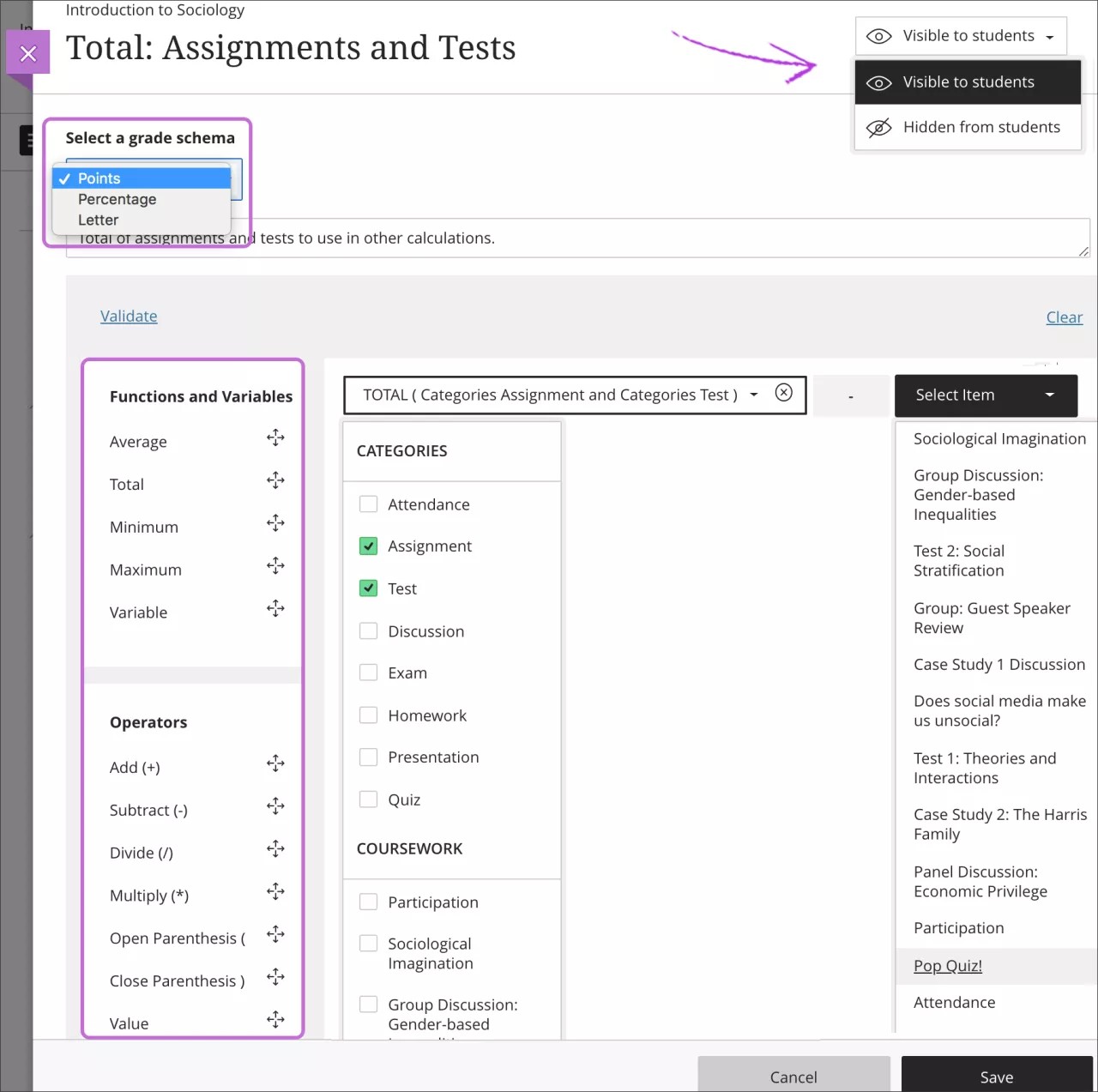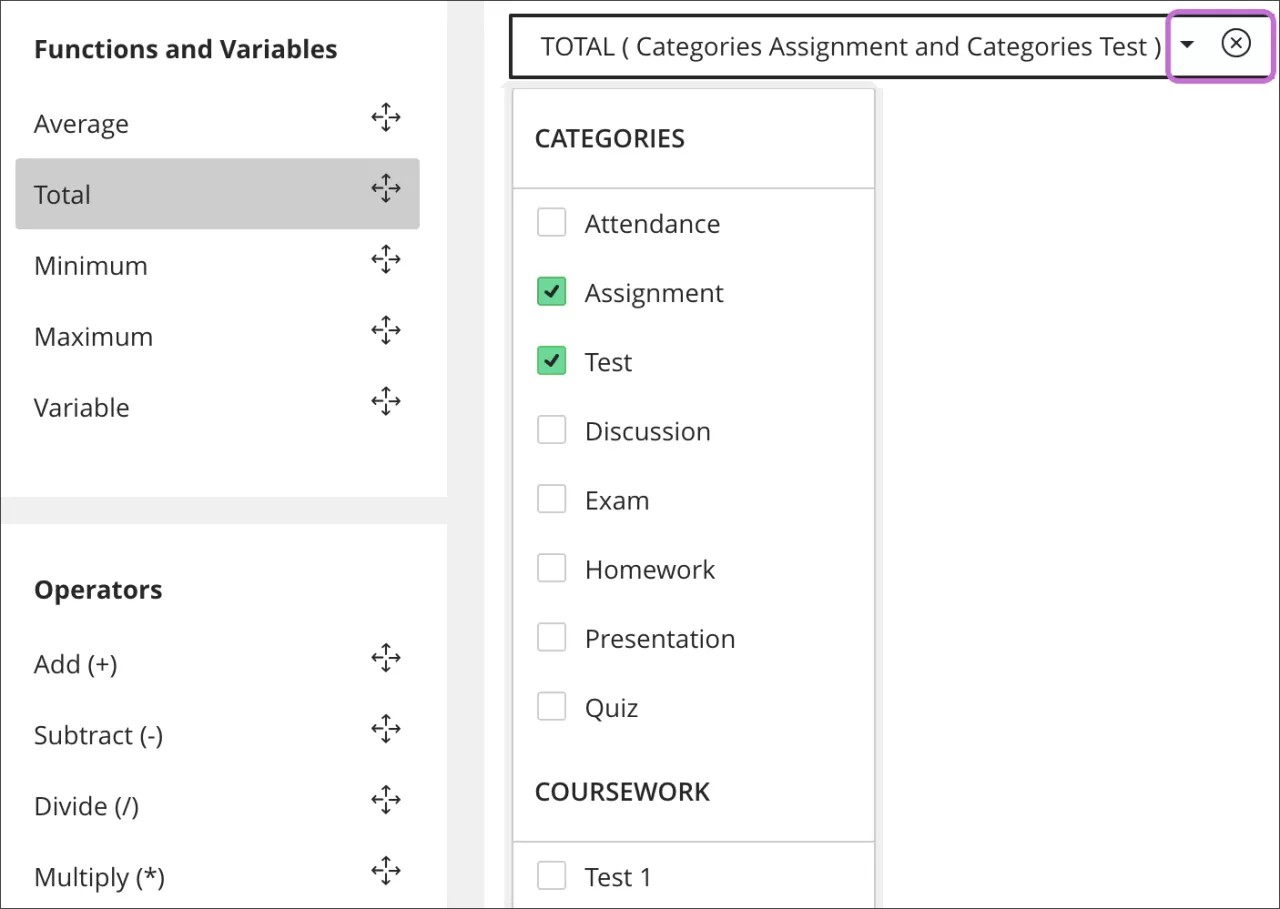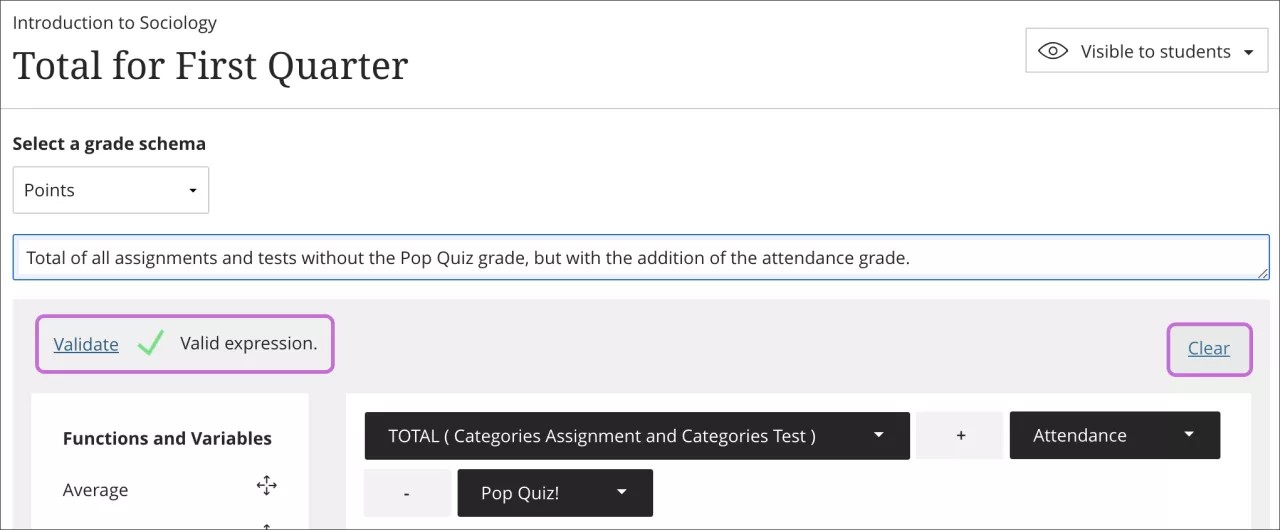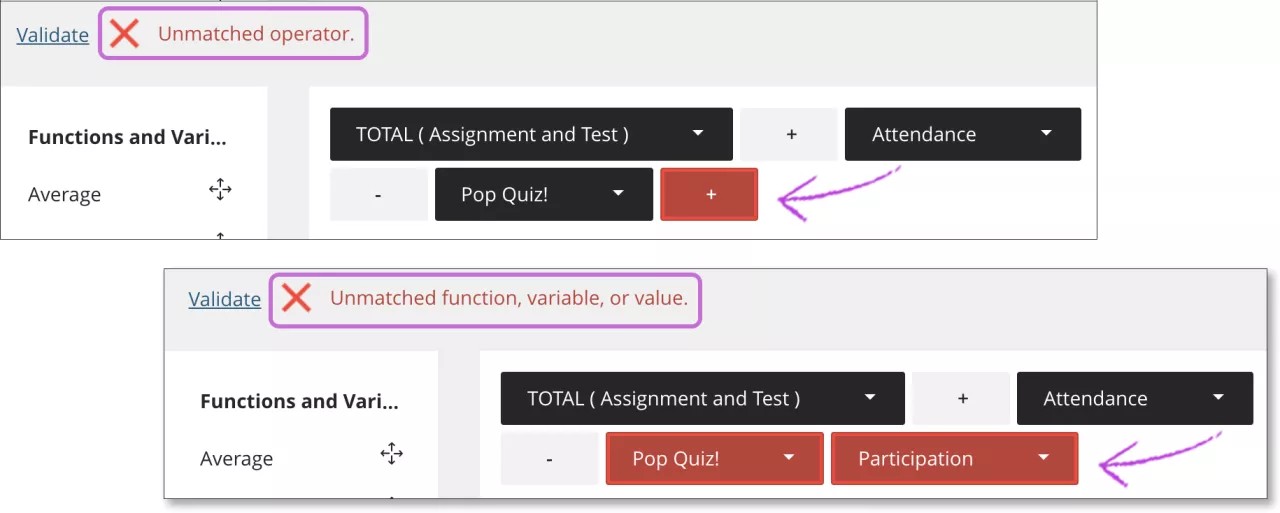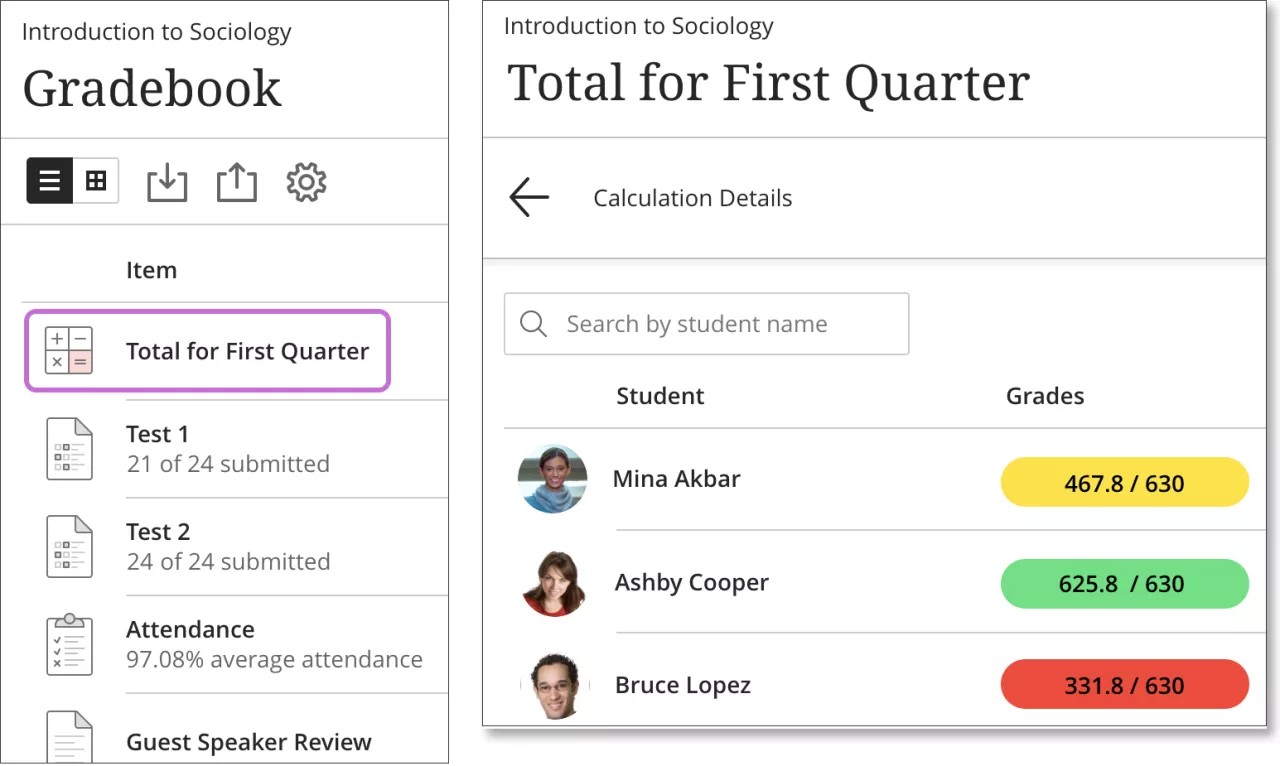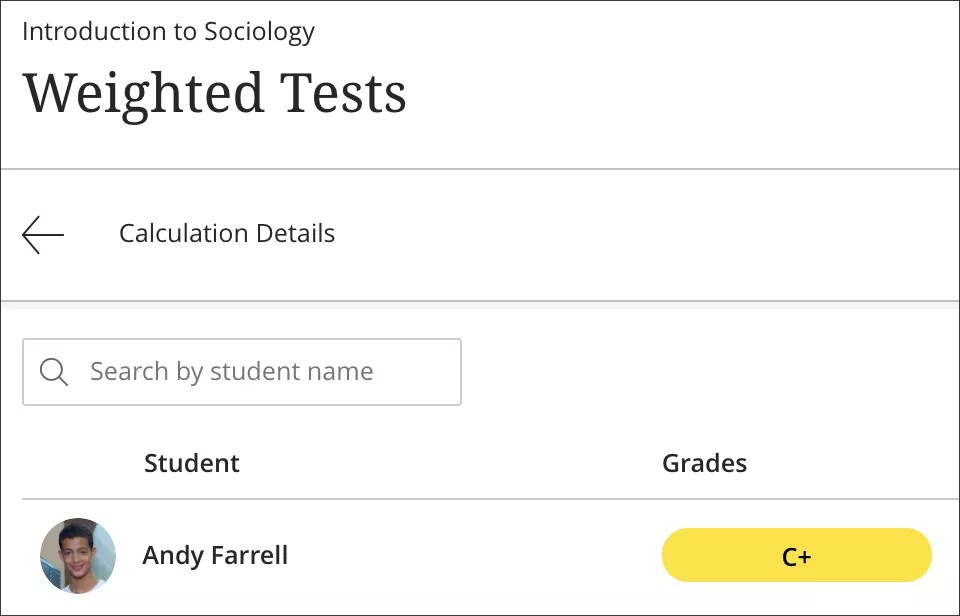Your institution controls which tools are available in the Original Course View. The gradebook is always available to instructors in the Ultra Course View.
About gradebook calculations
You can easily add calculations to your course gradebook. A calculation is a formula that produces a numerical result used to view or assign grades, usually based on other graded items.
You can create your own formulas and use common arithmetic operations, including addition, subtraction, multiplication, and division, and use group operators (parentheses).
You can add calculations based on the average, total, maximum, or minimum of the variables you include, such as categories, graded items, and other calculations. For example, add a calculation that displays the average of all assignments so students have an overall picture of their performance. You can add as many calculations as you need.
In the Ultra Course View, each course has one default grading schema used for grades and calculations. You can't create new schemas at this time, but you can make changes to the default schema.
More on the default grading schema
More on grade calculations and decimal handling
Create calculations inline
In the Gradable Items or Grades view, select the plus sign wherever you want to add a calculation and select Add Calculation.
Calculation interface
Type a meaningful title for the calculation. If you don't add a title, New Calculation and the date appear in the gradebook. You can use the placeholder text as the title if the formula on the page is valid and saved. Optionally, add a description and make the calculation column visible to students. Students see calculated grades on their Grades pages, but they don't see your descriptions or formulas.
Determine how the result of the calculation appears. In the Select a grade schema menu, choose Points, Percentage, or Letter.
Create your formula. In the left pane, select a function, variable, or operator to add it to the right pane.
Functions and Variables
- Average: Generates the average for a selected number of graded items, categories, and other calculations. For example, you can find the average score on all tests.
- Total: Generates a total based on the cumulative points, related to the points allowed. You can select which graded items, categories, and other calculations are included in the calculation.
- Minimum: Generates the minimum grade for a selection of graded items, categories, and other calculations. For example, you can find the minimum score on all assignments.
- Maximum: Generates the maximum grade for a selection of graded items, categories, and other calculations. For example, you can find the maximum score on all discussions.
- Variable: Select an individual graded item or calculation from the menu. You may only add one variable at a time. Continue to add variables from the left pane to add as many variables as you need.
Operators
- Add ( + )
- Subtract ( - )
- Divide ( / )
- Multiply ( * )
- Open Parenthesis (
- Close Parenthesis )
- Value: After the text box appears in the formula, click in the box to add a numeric value. You can include seven digits before a decimal point and four digits after it. When the calculation is generated and appears in students' grade pills, only two digits appear after the decimal point.
Create your formula
For example, select Total in the left pane to add that function to the right pane. Expand the list and select the check boxes for the items you want to add to the formula. When you choose a category, all items in that category are included. You must choose graded items and other calculations individually. Scroll through the list to view all items. In the Variable menu, select an item to choose it.
After you make a selection in a menu, click anywhere outside of the menu to exit and save the selection in the right pane. Each element you add to the formula appears at the end. You can press and drag any added element to reorder your formula. To remove an element, select it and select the X. You can reuse any function, variable, or operator.
When you select Save or Validate, the system checks the accuracy of your formula. Validate checks the formula while you remain on the page. You can't save a calculation until it's mathematically valid.
Select Clear to remove all elements from the right pane and start over.
Example formula for the total for the first quarter:
Create a Total calculation that includes the Assignment and Test categories and the Attendance grade, but doesn't include the Pop Quiz grade.
The Assignment and Test categories are in the Total menu. Attendance and Pop Quiz are individual graded items in the Variable menu.
Formula: Total of Assignment category + Test category + Attendance - Pop Quiz
If the formula isn't valid, an inline error message appears next to Validate. Problems in your formula are highlighted in red in the right pane.
Example error messages:
- Unmatched operator: Symbols such as (+) or ( -) don't match up with another part of the formula. Example: Graded item + (nothing).
- Unmatched function, variable, or value: Typically appears when an operator is missing between two variables, such as two graded items or categories.
- Some error messages are specific, such as Unmatched opening parenthesis, to alert you to exactly what's missing.
Your newly created calculated item appears in your gradebook. In Gradable items view, select the Move button in the row of the calculation to drag it to a new location and release. The order you choose also appears in the Grades and student Grades views.
Reminder: Students won't see the calculation until it has a grade and you make the item visible to them.
Delete graded items in a calculation
If you delete a graded item used in a calculation, you receive a warning when you open the calculation:
An item was removed from the gradebook that was used in this calculation. We've updated the calculation where possible, but it may need your attention.
You may need to update the calculation. Students see the updated calculation on their Grades pages if you made the calculation visible to them.
Create weighted calculations
A weighted calculation generates a grade based on the result of selected graded items, categories, other calculations, and their respective percentages. You can use normal arithmetic operations to create the weighting you need.
For example, if you have four tests and one final test, you can weight each for a "Weighted Tests" calculation.
Select tests individually from the Variable menu and select Value to add the percentage for each test, such as .15. Add the operators needed such as Multiply and Add.
Basic formula:
Test 1 x .15 + Test 2 x .15 + Test 3 x .15 + Test 4 x .15 + Final Exam x .40
You can include parentheses in this example if you want:
(Test 1 x .15) + (Test 2 x .15) + (Test 3 x .15) + (Test 4 x .15) + (Final Exam x .40)
The calculation is valid either way and produces the same result.
In item list view, select the calculation to view each student's calculated grade or access the student Grades view and navigate to the column.
More on weighting and the overall grade
Keyboard commands
If you use keyboard navigation, you can tab between panes to build a formula.
Add functions and operators to the formula. In the Function and Operator panes, use the up and down arrow keys to select an item from the list and press Enter to add it to the formula.
Reorder the formula. Focus on a formula item and press Enter. Use the arrow keys to move the item and press Enter again to place it.
Select items to include in functions. Focus on a function or variable in the formula and press Spacebar. From the menu, select the gradebook items to include. Press Esc to close the menu.


